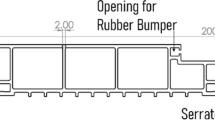Abstract
The unbalanced flow problem often occurs at die exit in the extrusion process of plastic profile, which directly influences the performance of final products. For the lack of corresponding theoretical basis, reasonable extrusion die design is still a difficult task, especially for the complex hollow profile. With the development of computational fluid dynamics theory, numerical method becomes an effective way to investigate the complex material forming problems. In the present study, a design strategy for complex hollow profile extrusion die was proposed based on the principles of flow balance. The mathematical model for three-dimensional non-isothermal polymer melt flow within complex extrusion die runner was developed based on the computational fluid dynamics (CFD) theory. The governing equations were deduced based on the finite volume method, and the pressure-velocity coupling problem was solved by using the Semi-Implicit Method for Pressure-Linked Equations (SIMPLE) algorithm. The Arrhenius equation was employed to involve the temperature dependence of material parameters. The flow characteristics of PVC polymer melts in the extrusion process of complex hollow profile were investigated. The distributions of principal field variables including flow velocity, melt temperature, and pressure drop were obtained. The effects of die geometric parameters on the velocity distribution uniformity were further analyzed, and a design strategy was proposed to achieve the flow balance in complex plastic profile extrusion process.
Similar content being viewed by others
References
Gonçalves ND, Carneiro OS, Nóbrega JM (2013) Design of complex profile extrusion dies through numerical modeling. J Non-Newton Fluid 200(20):103–110
Elgeti S, Probst M, Windeck C, Behr M, Michaeli W (2012) Numerical shape optimization as an approach to extrusion die design. Finite Elem Anal Des 61(6):35–43
Mu Y, Zhao GQ, Chen AB, Wu XH (2013) Modeling and simulation of polymer melts flow in the extrusion process of plastic profile with metal insert. Int J Adv Manuf Tech 67(1–4):629–646
Mu Y, Zhao GQ, Wu XH, Hang LQ, Chu HH (2015) Continuous modeling and simulation of flow-swell-crystallization behaviors of viscoelastic polymer melts in the hollow profile extrusion process. Appl Math Model 39(3–4):1352–1368
Koziey BL, Vlachopoulos J, Vlcek J (1996) Profile die design by pressure balancing and cross flow minimization. Proceedings of SPE Annual Technical Conference: 247–252
Hurez P, Tanguy PA, Blouin D (1993) Numerical simulation of profile extrusion dies without flow separation. Polym Eng Sci 33(15):971–979
Ettinger HJ, Sienz J, Pittman JFT, Polynkin A (2004) Parameterization and optimization strategies for the automated design of uPVC profile extrusion dies. Struct Multidiscip O 28(10):180–194
Mu Y, Zhao GQ, Wu XH, Zhang CR (2010) An optimization strategy for die design in the low-density polyethylene annular extrusion process based on FES/BPNN/NSGA-II. Int J Adv Manuf Tech 50(5):517–532
Yilmaz O, Gunes H, Kirkkopru K (2014) Optimization of a profile extrusion die for flow balance. Fiber Polym 15(4):753–761
Carneiro OS, Nóbrega JM, Pinho FT, Oliveira PJ (2001) Computer aided rheological design of extrusion dies for profiles. Journal Mater Process Tech 114(1):75–86
Švábík J, Plaček L, Sáha P (1999) Profile die design based on flow balancing. Int Polym Process 14(3):247–253
Nóbrega JM, Carneiro OS, Oliveira PJ, Pinho FT (2002) Flow balancing in extrusion dies for thermoplastic profiles: part I: automatic design. Int Polym Process 19(3):225–235
Carneiro OS, Nóbrega JM (2004) Recent developments in automatic die design for profile extrusion. Plast Rubber Compos 33(33):400–408
Toméa MF, Araujoa MSBD, Alvesb MA, Pinho FT (2008) Numerical simulation of viscoelastic flows using integral constitutive equations: a finite difference approach. J Comput Phys 227(8):4207–4243
Matsuoka T, Takahashi H (1991) Finite element analysis of polymer melt flow in profile extrusion coating die. Int Polym Process 6(3):183–187
Kim JM, Kim C, Kim JH, Chung CK, Ahn KH, Lee SJ (2005) High-resolution finite element simulation of 4:1 planar contraction flow of viscoelastic fluid. J Non-Newton Fluid 129:23–37
Wachs A, Clermont JR (2000) Non-isothermal viscoelastic flow computations in an axisymmetric contraction at high Weissenberg numbers by a finite volume method. J Non-Newton Fluid 95:147–184
Alvesa MA, Pinho FT, Oliveira PJ (2001) The flow of viscoelastic fluids past a cylinder: finite-volume high-resolution methods. J Non-Newton Fluid 97:207–232
Beris AN, Dimitropoulos CD (1999) Pseudospectral simulation of turbulent viscoelastic channel flow. Comput Method Appl M 180(3–4):365–392
Gao XW (2005) A promising boundary element formulation for three-dimensional viscous flow. Int J Numer Meth Fl 47:19–43
Nguyen-Thien T, Tran-Cong T (2000) BEM-neural network approach for polymeric liquids flow analysis. Eng Anal Bound Elem 24:95–106
Mu Y, Zhao GQ, Wu XH, Zhai JQ (2013) Finite-element simulation of polymer flow and extrudate swell through hollow profile extrusion die with the multimode differential viscoelastic model. Adv Polym Tech 32:1–19
Meijerink JA, van der Vorst HA (1977) An iteration solution method for linear systems of which the coefficient matrix is a symmetric matrix. Math Comput 31(137):148–162
van der Vorst HA (1992) Bi-CGSTAB: a fast and smoothly converging variant of Bi-CG for the solution of nonsymmetric linear systems. SIAM J Sci Comput 13(2):631–644
Patankar SV, Spalding DB (1972) A calculation procedure for heat, mass and momentum transfer in three-dimensional parabolic flows. Int J Heat Mass Tran 15(10):1787–1806
Author information
Authors and Affiliations
Corresponding authors
Rights and permissions
About this article
Cite this article
Mu, Y., Hang, L., Chen, A. et al. Influence of die geometric structure on flow balance in complex hollow plastic profile extrusion. Int J Adv Manuf Technol 91, 1275–1287 (2017). https://doi.org/10.1007/s00170-016-9790-y
Received:
Accepted:
Published:
Issue Date:
DOI: https://doi.org/10.1007/s00170-016-9790-y



